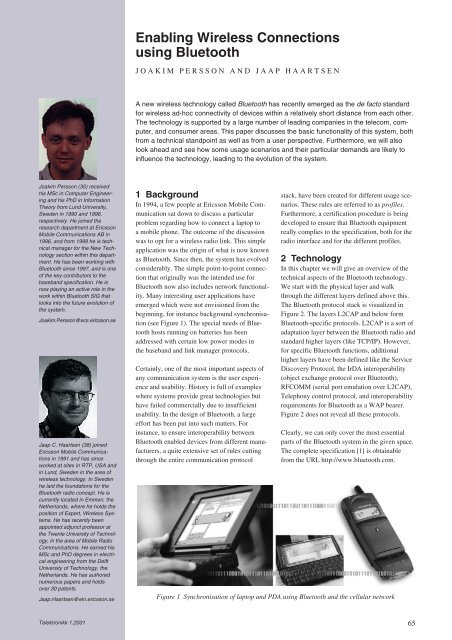You also want an ePaper? Increase the reach of your titles
YUMPU automatically turns print PDFs into web optimized ePapers that Google loves.
Joakim Persson (35) received<br />
his MSc in Computer Engineering<br />
and his PhD in Information<br />
Theory from Lund University,<br />
Sweden in 1990 and 1996,<br />
respectively. He joined the<br />
research department at Ericsson<br />
Mobile Communications AB in<br />
1996, and from 1999 he is technical<br />
manager for the New Technology<br />
section within this department.<br />
He has been working with<br />
Bluetooth since 1997, and is one<br />
of the key contributors to the<br />
baseband specification. He is<br />
now playing an active role in the<br />
work within Bluetooth SIG that<br />
looks into the future evolution of<br />
the system.<br />
Joakim.Persson@ecs.ericsson.se<br />
Jaap C. Haartsen (38) joined<br />
Ericsson Mobile Communications<br />
in 1991 and has since<br />
worked at sites in RTP, USA and<br />
in Lund, Sweden in the area of<br />
wireless technology. In Sweden<br />
he laid the foundations for the<br />
Bluetooth radio concept. He is<br />
currently located in Emmen, the<br />
Netherlands, where he holds the<br />
position of Expert, <strong>Wireless</strong> Systems.<br />
He has recently been<br />
appointed adjunct professor at<br />
the Twente University of Technology,<br />
in the area of Mobile Radio<br />
Communications. He earned his<br />
MSc and PhD degrees in electrical<br />
engineering from the Delft<br />
University of Technology, the<br />
Netherlands. He has authored<br />
numerous papers and holds<br />
over 30 patents.<br />
Jaap.Haartsen@eln.ericsson.se<br />
Telektronikk 1.2001<br />
Enabling <strong>Wireless</strong> Connections<br />
using Bluetooth<br />
JOAKIM PERSSON AND JAAP HAARTSEN<br />
A new wireless technology called Bluetooth has recently emerged as the de facto standard<br />
for wireless ad-hoc connectivity of devices within a relatively short distance from each other.<br />
The technology is supported by a large number of leading companies in the telecom, computer,<br />
and consumer areas. This paper discusses the basic functionality of this system, both<br />
from a technical standpoint as well as from a user perspective. Furthermore, we will also<br />
look ahead and see how some usage scenarios and their particular demands are likely to<br />
influence the technology, leading to the evolution of the system.<br />
1 Background<br />
In 1994, a few people at Ericsson Mobile Communication<br />
sat down to discuss a particular<br />
problem regarding how to connect a laptop to<br />
a mobile phone. The outcome of the discussion<br />
was to opt for a wireless radio link. This simple<br />
application was the origin of what is now known<br />
as Bluetooth. Since then, the system has evolved<br />
considerably. The simple point-to-point connection<br />
that originally was the intended use for<br />
Bluetooth now also includes network functionality.<br />
Many interesting user applications have<br />
emerged which were not envisioned from the<br />
beginning, for instance background synchronisation<br />
(see Figure 1). The special needs of Bluetooth<br />
hosts running on batteries has been<br />
addressed with certain low power modes in<br />
the baseband and link manager protocols.<br />
Certainly, one of the most important aspects of<br />
any communication system is the user experience<br />
and usability. History is full of examples<br />
where systems provide great technologies but<br />
have failed commercially due to insufficient<br />
usability. In the design of Bluetooth, a large<br />
effort has been put into such matters. For<br />
instance, to ensure interoperability between<br />
Bluetooth enabled devices from different manufacturers,<br />
a quite extensive set of rules cutting<br />
through the entire communication protocol<br />
stack, have been created for different usage scenarios.<br />
These rules are referred to as profiles.<br />
Furthermore, a certification procedure is being<br />
developed to ensure that Bluetooth equipment<br />
really complies to the specification, both for the<br />
radio interface and for the different profiles.<br />
2 Technology<br />
In this chapter we will give an overview of the<br />
technical aspects of the Bluetooth technology.<br />
We start with the physical layer and walk<br />
through the different layers defined above this.<br />
The Bluetooth protocol stack is visualized in<br />
Figure 2. The layers L2CAP and below form<br />
Bluetooth-specific protocols. L2CAP is a sort of<br />
adaptation layer between the Bluetooth radio and<br />
standard higher layers (like TCP/IP). However,<br />
for specific Bluetooth functions, additional<br />
higher layers have been defined like the Service<br />
Discovery Protocol, the IrDA interoperability<br />
(object exchange protocol over Bluetooth),<br />
RFCOMM (serial port emulation over L2CAP),<br />
Telephony control protocol, and interoperability<br />
requirements for Bluetooth as a WAP bearer.<br />
Figure 2 does not reveal all these protocols.<br />
Clearly, we can only cover the most essential<br />
parts of the Bluetooth system in the given space.<br />
The complete specification [1] is obtainable<br />
from the URL http://www.bluetooth.com.<br />
Figure 1 Synchronisation of laptop and PDA using Bluetooth and the cellular network<br />
65

















